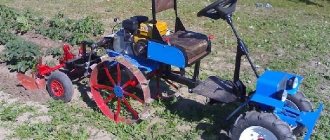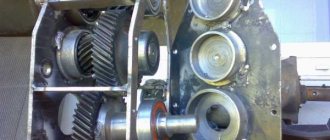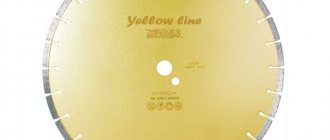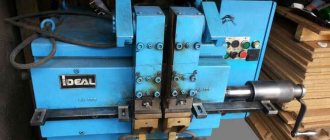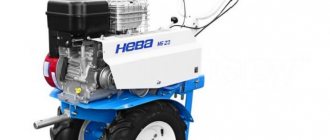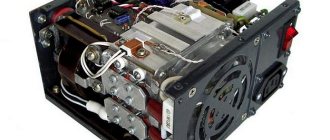The main products produced by JSC KO-Neva are
walk-behind tractors and walk-behind cultivators . These products are manufactured under the brand name “Mototekhnika NEVA”. The products are designed to perform a wide range of agrotechnical and economic operations (ploughing, cultivation, weeding, hilling, planting potatoes, digging up root crops, watering, cleaning the territory, transporting goods). One of the key mechanisms of motor vehicles that ensures their reliability and operational efficiency is the gearbox. You can buy a gearbox for the NEVA walk-behind tractor, as well as a walk-behind tractor, cultivator and attachments in the stores of our sales representatives , as well as at the trade and exhibition complex in St. Petersburg . The price of the product may vary depending on the region of sale. You can install the transmission on the equipment yourself, or by contacting a service center .
- Worm gear
- Chain reducer
- Gear reducer
- Gear-chain reducer
What is a gearbox for a walk-behind tractor?
The standard gearbox of a walk-behind tractor is a power unit that transmits torque from the engine and transmission directly to the working shaft on which cutters or wheels are mounted.
It bears a significant power (work) load. Modern walk-behind tractors use different technical solutions for this unit:
- gear transmissions;
- chain;
- worm;
- combined.
The gear housing (housing) is sealed. There is a gasket between the body and the cover. The seal is necessary to retain the oil. All rotating parts of the unit operate in an oil bath.
Located at the bottom of the walk-behind tractor in the center. On cheap models it may be non-separable and cannot be repaired.
Application of gears
The scope of application of gearboxes is wide - from mini-drives in medical equipment to industrial power plants. They found a place in agriculture, metallurgy, the coal industry, mechanical engineering, shipping and automobiles. Gear reducers are used in different climatic conditions - indoors, outdoors, in heat, cold and even in arctic conditions.
The use of gear systems is due not only to the ability to change the direction of shaft movement. With the help of gears, the rotation speed increases and decreases, and the torque on the shaft changes (more often increases).
Classification of gearboxes used on walk-behind tractors and their characteristics
Below are the main types of such units that can be found on modern walk-behind tractors.
Angular
This type gets its name because it turns and transmits torque at an angle. Most often at a straight line, 90 degrees. This may be necessary when installing attachments - a rotary snow blower, a header, an active cutter, etc.
Angular gearboxes can be zero, which do not change the speed. And also increasing or decreasing. Overdrives increase the number of revolutions of the output shaft in comparison with the input, which results in a loss of power. Downshifts, on the contrary, reduce the output speed and increase force.
The picture shows an angular gearbox for mounting a snow blower:
The output speed is determined by the needs of the attachment. Where high speeds of the working body are required, booster units are installed. Where low speeds and power are needed, on the contrary, lowering ones are installed.
Downward
The operating principle of all reduction gearboxes is simple: a small gear rotates a larger one in diameter. A larger gear has a larger radial arm. The greater the leverage, the greater the force.
Most gearboxes have several gears that alternately transmit torque to each other. A reduction gear can be any type: worm, gear, chain or combined.
Some engines for walk-behind tractors are equipped from the factory with a reduction gearbox with a gear ratio of approximately 2:1. That is, at the output from the engine shaft, for example, 3600 rpm. At the output from the reduction gear shaft - 1800 rpm. But the rotation force is 2 times greater.
This is the engine in the picture. In the foreground is the cover and shaft of the reduction gearbox for a motor cultivator:
This is a complex mechanism equipped with an automatic (centrifugal) clutch.
But it cannot be considered as some kind of separate special device. This is an integral part of such a motor.
Motoblocks also use other reduction gears, most often homemade.
Gear
These are gearboxes in which rotation is transmitted using gears. Due to the dense and deep engagement of the gear teeth with each other, large power loads are transmitted. Knots of this type are used on the most powerful machines and mechanisms.
Gears are made of special durable steel that is resistant to breakage and abrasion. They rotate in oil, which extends their service life.
The image shows a repair kit, a set of gears for such a gearbox:
Disadvantage of this type: manufacturing high-quality gears with minimal tolerances is a high-tech, expensive process. High-quality gearboxes are expensive. If, in order to reduce the cost, the parts are made of poor quality, the unit does not last long.
Worm
A spiral helical worm gear rotates the gear. At the same time, the speed decreases many times and the force on the output shaft of the gear increases.
The advantages of this solution are simplicity, a minimum of parts, and a rigid grip.
The downside is that with constant rotation, the rubbing surfaces of the spiral and gear teeth wear out quite quickly. Especially if they are made of low-quality alloys and with large tolerances (low accuracy).
The photo shows an example of such a gearbox:
Gearboxes of this type are very suitable for opening gates, covers of industrial equipment, etc., that is, where the mechanism makes a minimum of revolutions. And the revs themselves are low. With constant loads and rotation of the working shaft of the walk-behind tractor, wear can be accelerated.
Varieties
The gearboxes with which walk-behind tractors are equipped seem identical only at first glance. In fact, these devices can be divided into three groups. The differences lie in the design features of the gearboxes. Let's get to know the representatives of this family in more detail.
Angular
Angle-type gearboxes are elementary structures that serve to connect the transmission to the power plant of the unit.
Due to the absence of complex components, some farmers install homemade versions of angular gearboxes on walk-behind tractors.
The structure of this node looks like this:
- Mechanism body.
- Belt drive pulley with fastening.
- Rotor shaft.
- Flange complete with mounting and bearing.
- Washer and fixing key.
Gear
This is a more complex mechanism, which is impossible to recreate at home without special skills and knowledge.
Gear reducers are called reduction gearboxes. Thanks to its design features, the mechanism reduces the engine speed, simultaneously increasing the power output of the walk-behind tractor.
Such gearboxes have a long service life, so they are suitable for performing various jobs, and do not suffer mechanical damage even under peak loads.
Unlike angular models, reduction gearboxes require additional cooling.
Reversible
This mechanism is based on a clutch that moves freely between bevel gears.
Such gearboxes enable the walk-behind tractor to move in reverse, which has a positive effect on the maneuverability of the equipment.
However, this comes at the cost of reduced performance and maximum speed. Therefore, each farmer decides independently whether to install a reversible gearbox or not.
Gearboxes installed on walk-behind tractors from different manufacturers have virtually no design differences. Therefore, disassembling the unit and replacing failed parts will not cause difficulties.
The exception is budget walk-behind tractors made in China. A non-separable gearbox is installed here, which in case of breakdown can be replaced entirely.
Design and principle of operation
The design and operating principle of the main types of gearboxes are described above. In addition to them, chain gearboxes are used on walk-behind tractors; this design is used on Cascade brand cultivators. They operate with gears, the rotation between which is transmitted using chains. They have reverse.
There are also combined mechanisms. The picture below is gear-chain type:
Criteria for selecting a walk-behind tractor by gearbox type
If the walk-behind tractor is low, it means it is equipped with a gear reducer. This type is compact, so the entire walk-behind tractor and its center of gravity are located noticeably lower than other options.
A low unit is easier to work with. There are no chains that tend to stretch over time, which leads to malfunction. The downside of this option is that it is noisier. And there are problems if the parts of the assembly are made of poor quality, from cheap alloys. In terms of complexity, such a unit is comparable to gearboxes of a car and other machines and units.
The most common type of gearbox on walk-behind tractors is the gear-chain gearbox, shown in the image above. It combines the advantages of a gear and chain gearbox, but has the same general disadvantages - chain stretching. The gearbox is tall, so units with it have a high center of gravity.
Worm
With such a gearbox, it is better not to use attachments; work only with cutters. This type of gearbox is suitable for walk-behind tractors that will work in small areas where the soil has already been previously cultivated.
- High efficiency due to the absence of belt drives.
- This type of gearbox is the most affordable.
- Compactness.
- High peak loads cause attachments to become unusable.
- Short service life.
- Questionable reliability.
Reliable worm pairs made of high-quality metal are found in imported cultivators, but they are also expensive. Heavy loads can cause overheating, shearing of gear teeth and damage to the worm. The worm gearbox is suitable for small and pre-prepared areas.
Making your own gearbox step by step
It is impossible to make a full-fledged gearbox with a crankcase, axles (shafts) on bearings and sets of gears or chain sprockets on your own. This is a complex assembly that requires a production line with many high-precision machines to produce. Sometimes owners adapt ready-made reduction or angular gearboxes from other machines and mechanisms for their units.
The simplest version of a reduction gear (more precisely, a reduction gear) is shown in the following video:
Chains and chain sprockets from a motorcycle were used here. It is impossible to describe step by step all the actions of such tuning. Main stages:
- In front of the factory gearbox, a homemade stand is placed under the working shaft, on bearings.
- Large gears from a motorcycle, a pair, are attached to the working shaft. One on each side of the rack.
- Small sprockets are mounted on the shaft located in the factory gearbox.
- Chains are stretched between the sprockets, like on a motorcycle.
The design must include a device for adjusting chain tension.
Model range of gearboxes for walk-behind tractors
All gearboxes of the above types are on sale. When choosing a new gearbox, you should first of all take into account compatibility - the unit must simply match the specific model in terms of dimensions, mountings, and gear ratio. At the same time, the specificity of modern walk-behind tractors is that the same model can have both different engines and gearboxes.
For example, let’s compare the well-known and popular Russian walk-behind tractor Neva MB2 with the traditional and new Multiagro gearbox.
Traditional gearbox:
- unlocking on one wheel . When rotating, one wheel is easy to turn in only one direction;
- gear shifting on the gearbox cover , which is inconvenient when traveling with a trolley. You have to stop, get off the cart and approach the walk-behind tractor to change gears;
- 2 forward speeds, 1 reverse speed . If you transfer the transmission belt to pulleys with a different gear ratio, the number of speeds doubles. As a result, 4 speeds forward, 2 reverse.
New Multiagro gearbox:
- two wheel unlocking . The left and right locking handles are located on the steering wheel. With their help it is easy to turn in both directions, and not in one;
- gear shifting using a cable is moved from the gearbox housing to the steering wheel, which is convenient;
- more gears: 3 forward, 2 reverse . When throwing the belt 6 forward 2 back.
It is still difficult to compare the reliability and service life of these different models. The new unit has been on sale relatively recently, approximately since 2022. But it was developed and tested for quite a long time. In terms of functionality and convenience, Multiagro has a clear superiority. This is a Russian production, St. Petersburg, .
Cross-section of the Multiagro gearbox:
A gearbox with gear switching on a walk-behind tractor essentially gives only advantages; it is a kind of analogue of a car’s gearbox. This is the responsible node. If performed well, it can have a fairly long service life. The main thing that depends on the owner to extend the service life of such units is the smooth activation of speeds, control over the quantity and quality of oil.
How to do it?
Enthusiastic craftsmen assure that a simple gearbox for a walk-behind tractor can be straightened with your own hands in a home workshop. To do this, you need to have a certain set of tools and more or less skills in working with them.
You will need:
- ruler and caliper;
- a set of different screwdrivers;
- hacksaw;
- pliers and wire cutters;
- vice;
- hammer;
- welding machine if necessary;
- spare parts and consumables (oil seal, rubber gasket, bolts, gears, chain or belt, bearing, shafts).
Of course, sketches are needed for construction. Therefore, if you lack the skills to build them yourself, you can turn to ready-made ones from the Internet or specialized magazines.
If the converter is created on the basis of an existing old one, then first you should disassemble it, remove unnecessary parts and modify it.
If the gearbox is assembled from scratch, the housing must first be made. For these purposes, a fitting angle or metal plates that are welded together are suitable. Its size should easily accommodate all planned gears and pulleys.
By the way, gears and shafts can be removed from an old chainsaw.
Next, you need to calculate the gear ratio. It is necessary to select the number of gears and the length of the shafts. Usually they take the number of idle revolutions of the crankshaft as a basis and add 10 percent to it .
A simple homemade gearbox uses two opposing shafts. On one side there is a gear in which a hole needs to be drilled, on the other there is a shaft complete with a race and bearings. Next, the output shaft is mounted on the pulley. In this case, you must remember to insulate the shafts with oil seals so that the oil does not leak.
The assembled structure is inserted into the housing, into which lubricant or oil is poured. The converter is connected to the motor. Then the setting is carried out, for which the mechanism is launched.
You should pay attention to ensure that all parts are not deformed or warped.
The device does not need to be overloaded during testing; the components must break in and establish mutual action. Only after checking and eliminating all defects can the gearbox be used for work.
Read also: Contactor designation on a single-line diagram
To learn how to make a gearbox for a walk-behind tractor with your own hands, see the following video.
The gear reducer is designed to change the frequency and direction of shaft rotation. It transmits power from the engine to the desired machine component, which operates on the principle of rotational motion. In any power unit you can find gearboxes of different types, depending on their design and purpose.
